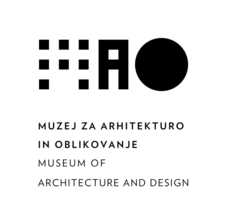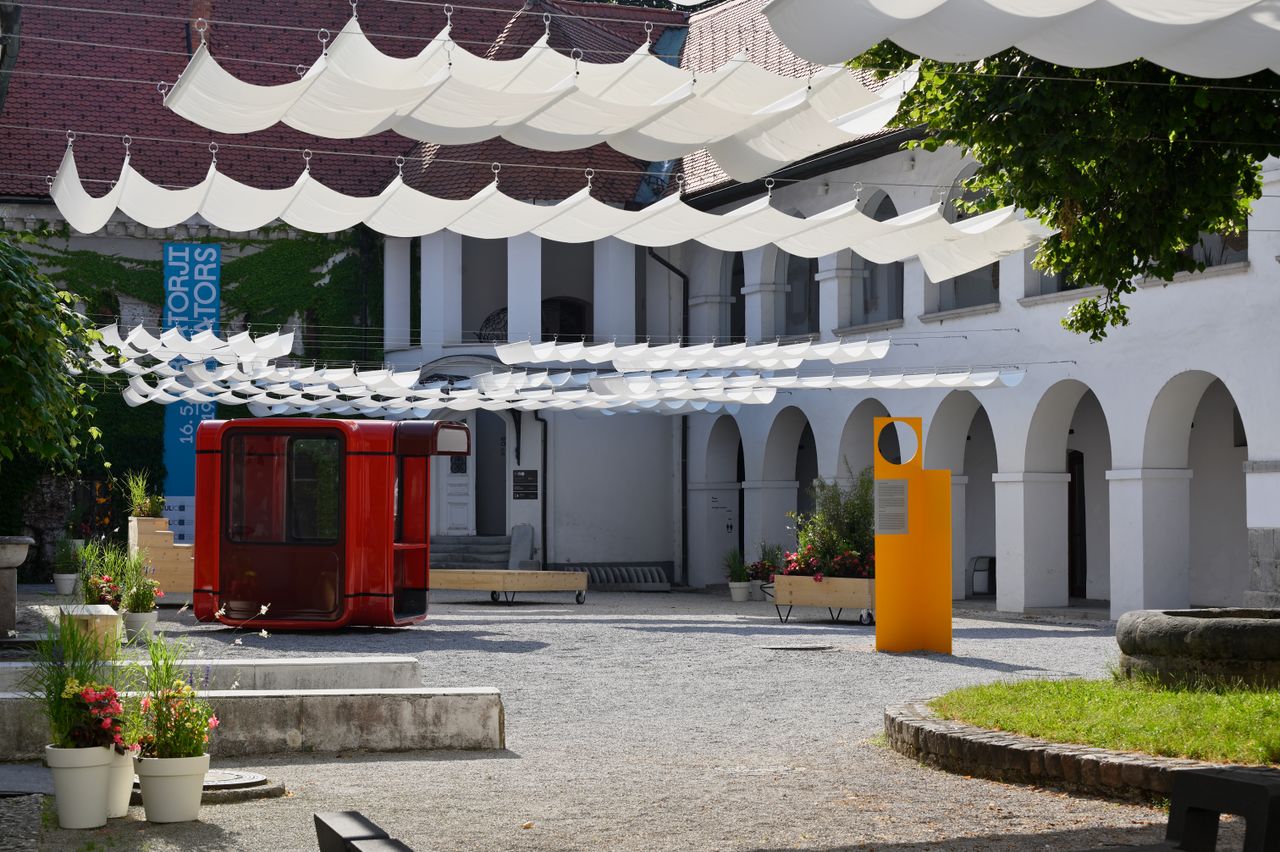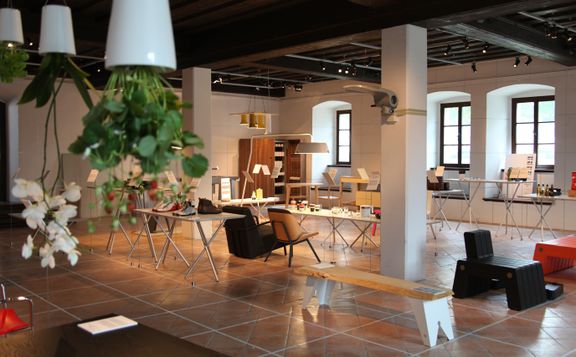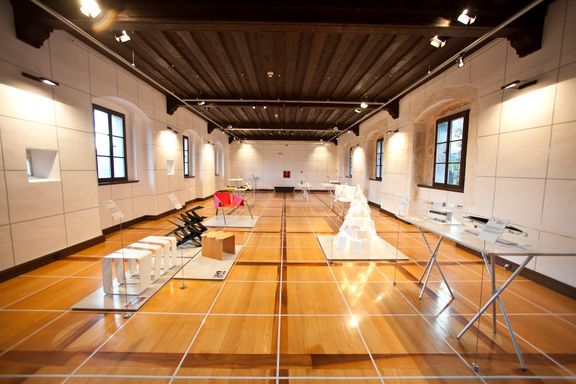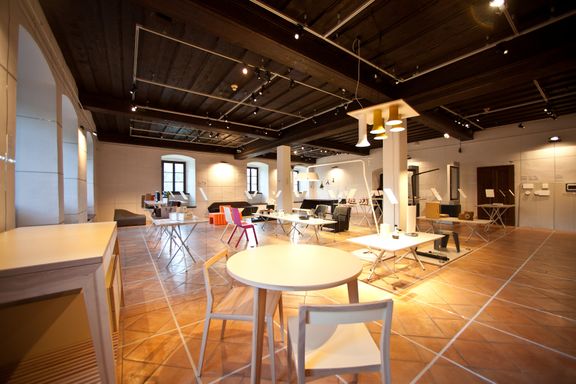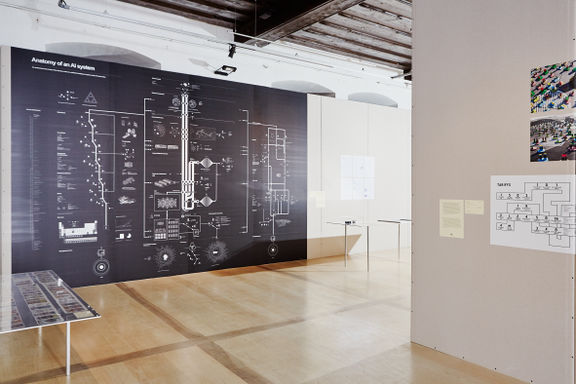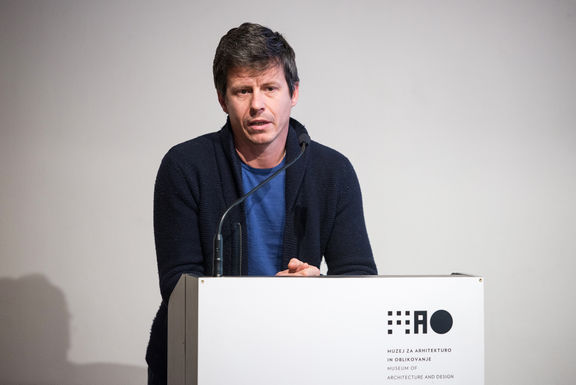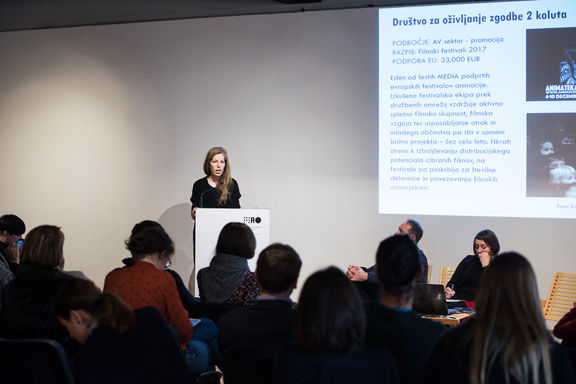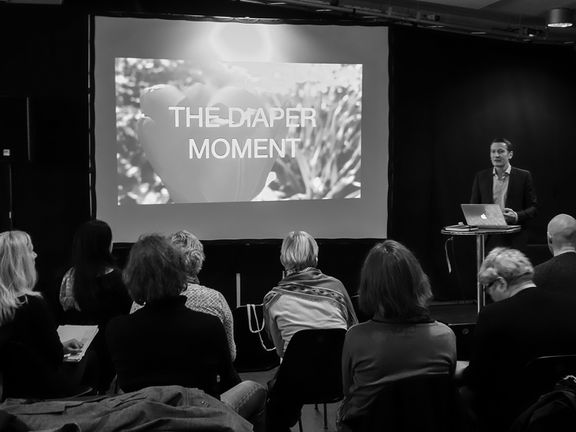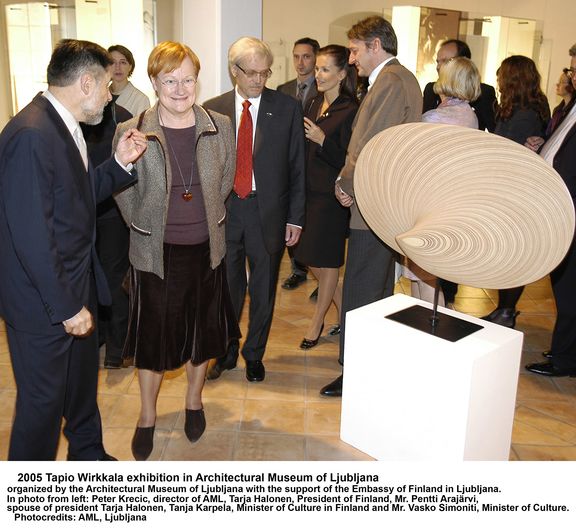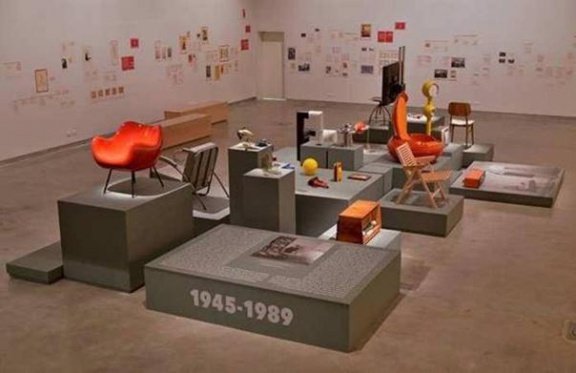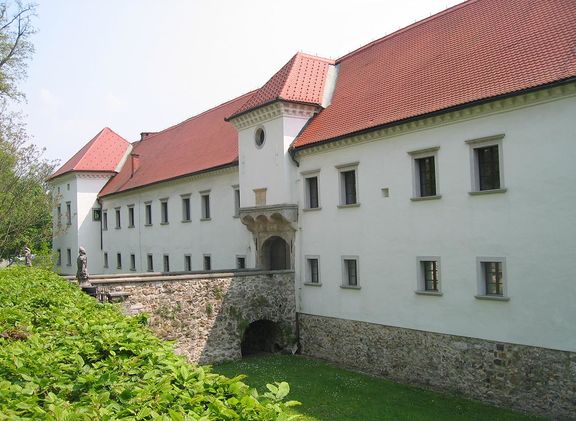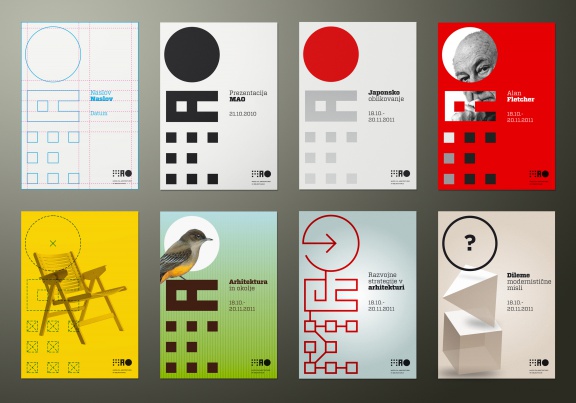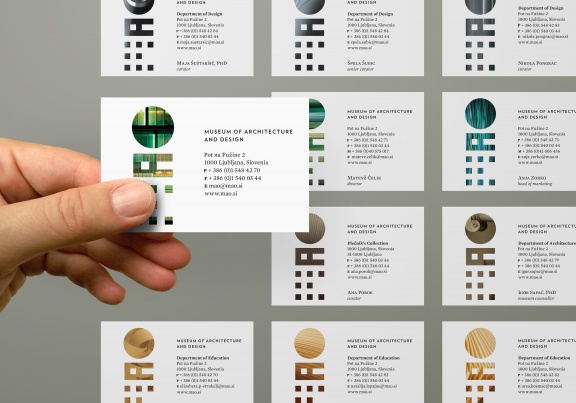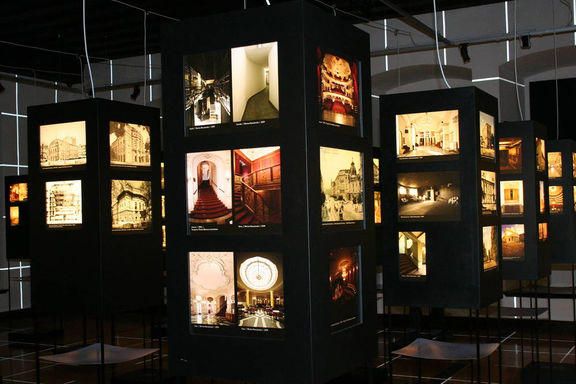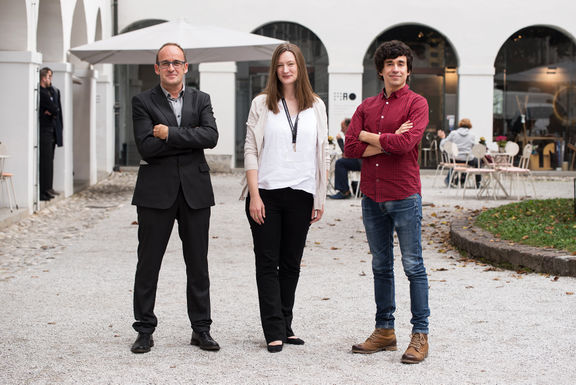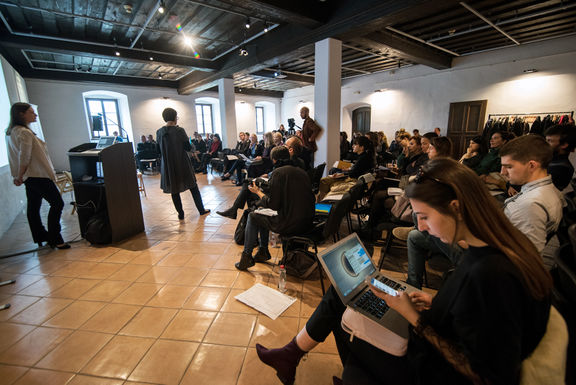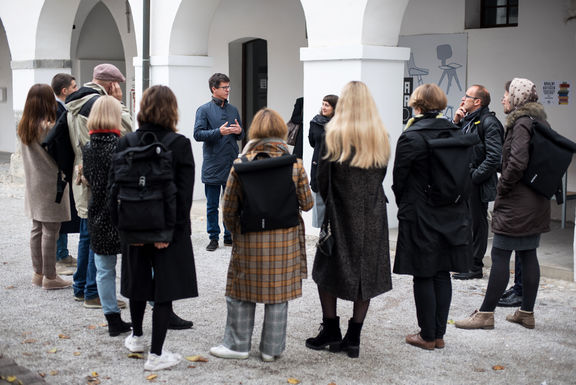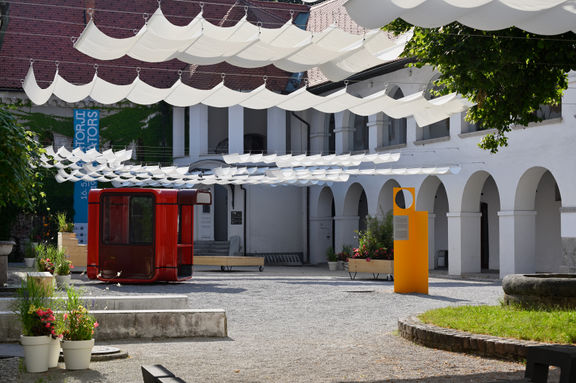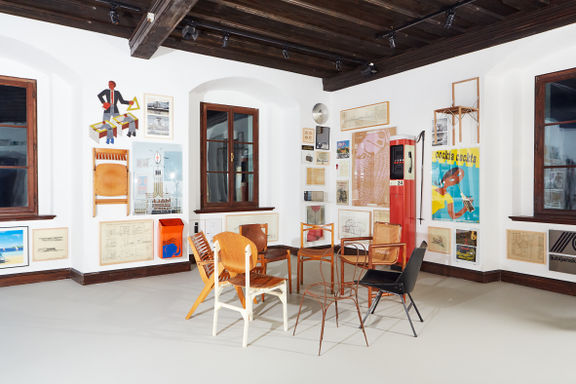Difference between revisions of "Museum of Architecture and Design"
(mwtool_article) |
|||
| (7 intermediate revisions by 3 users not shown) | |||
| Line 39: | Line 39: | ||
{{Teaser| | {{Teaser| | ||
| + | {{Image|Museum of Architecture and Design 2019 Courtyard Photo Miran Kambič.jpg}} | ||
| + | {{TeaserImgDesc|Museum of Architecture and Design 2019 Courtyard}} | ||
The Architecture Museum of Ljubljana was established in [[Established::1972]] by the [[Municipality of Ljubljana]]. In April 2010, the management of the museum was transferred from the city to the state. With the move of management came a new name, the [[Museum of Architecture and Design]] (Muzej za arhitekturo in oblikovanje (MAO)), and a central role as the main repository for documents and materials pertaining to architecture, town planning, industrial and graphic design, and photography in Slovenia. MAO has been located at [[Fužine Castle]] since 1992. | The Architecture Museum of Ljubljana was established in [[Established::1972]] by the [[Municipality of Ljubljana]]. In April 2010, the management of the museum was transferred from the city to the state. With the move of management came a new name, the [[Museum of Architecture and Design]] (Muzej za arhitekturo in oblikovanje (MAO)), and a central role as the main repository for documents and materials pertaining to architecture, town planning, industrial and graphic design, and photography in Slovenia. MAO has been located at [[Fužine Castle]] since 1992. | ||
| + | }} | ||
Since 1972, the administration of the [[Biennial of Design (BIO)]] (formerly known as the Biennial of Industrial Design) has operated under the aegis of the museum. Since 2017, MAO has additionally provided the operational framework for the [[Centre for Creativity]], a broadly-oriented project intended to provide support to Slovenia's cultural and creative sector (CCS). | Since 1972, the administration of the [[Biennial of Design (BIO)]] (formerly known as the Biennial of Industrial Design) has operated under the aegis of the museum. Since 2017, MAO has additionally provided the operational framework for the [[Centre for Creativity]], a broadly-oriented project intended to provide support to Slovenia's cultural and creative sector (CCS). | ||
| − | |||
| − | |||
| − | |||
== Activities == | == Activities == | ||
| − | |||
The activities of the Museum of Architecture and Design have expanded since the move to [[Fužine Castle]]. The museum now incorporates 4 departments: the Architecture Department, the Design Department, the Photography Department, and the Events Department. The museum also houses a specialised [[Museum of Architecture and Design Library|library]]. | The activities of the Museum of Architecture and Design have expanded since the move to [[Fužine Castle]]. The museum now incorporates 4 departments: the Architecture Department, the Design Department, the Photography Department, and the Events Department. The museum also houses a specialised [[Museum of Architecture and Design Library|library]]. | ||
| Line 58: | Line 57: | ||
== Programme == | == Programme == | ||
| − | |||
Materials and documents collected and studied at the Museum of Architecture and Design are displayed in the framework of various themed exhibitions. The exhibition ''The Architect Jože Plečnik 1872–1957'' was based on a major exhibition with the same title at the Georges Pompidou Centre in Paris in 1986. Special themed historical exhibitions focus on specific time periods and spaces: ''18th-Century Architecture in Slovenia'' (2007) and ''19th-Century Architecture in Slovenia'' (2013). Beside periodical exhibitions of Slovene architecture, the museum also hosts regular exhibitions of international architecture. | Materials and documents collected and studied at the Museum of Architecture and Design are displayed in the framework of various themed exhibitions. The exhibition ''The Architect Jože Plečnik 1872–1957'' was based on a major exhibition with the same title at the Georges Pompidou Centre in Paris in 1986. Special themed historical exhibitions focus on specific time periods and spaces: ''18th-Century Architecture in Slovenia'' (2007) and ''19th-Century Architecture in Slovenia'' (2013). Beside periodical exhibitions of Slovene architecture, the museum also hosts regular exhibitions of international architecture. | ||
MAO is also active in calling attention to the surprisingly rich history of industrial and consumer design in Slovenia. The exhibition ''Niko Kralj: The Unknown Famous Designer'' set a new standard for exhibitions of this kind: it showcased the archives, sketches, photographs, prototypes and final products of world-renowned Slovenian industrial designer [[Niko Kralj]] (1921–2013), including the famous Rex armchair, Lupina series, 4455 and modular system furniture Futura, Savinja, Javor, Konstrukta, as well as the Mosquito chair, which was designed as early as 1953, but due to the complexity of its manufacture, only entered into regular production in 2012. | MAO is also active in calling attention to the surprisingly rich history of industrial and consumer design in Slovenia. The exhibition ''Niko Kralj: The Unknown Famous Designer'' set a new standard for exhibitions of this kind: it showcased the archives, sketches, photographs, prototypes and final products of world-renowned Slovenian industrial designer [[Niko Kralj]] (1921–2013), including the famous Rex armchair, Lupina series, 4455 and modular system furniture Futura, Savinja, Javor, Konstrukta, as well as the Mosquito chair, which was designed as early as 1953, but due to the complexity of its manufacture, only entered into regular production in 2012. | ||
| − | |||
{{Vimeo|32418855}} | {{Vimeo|32418855}} | ||
== Education == | == Education == | ||
| − | |||
Educational activities, including creative workshops, take place regularly at the museum. Pedagogical events for groups of various ages are available throughout the week with a prior appointment, while the Sunday at MAO event series opens the museum's doors twice a month to children of all ages, presenting them with a range of fun, interactive activities through which they can learn about how architecture and design are made and the huge role they have in shaping our day-to-day lives. | Educational activities, including creative workshops, take place regularly at the museum. Pedagogical events for groups of various ages are available throughout the week with a prior appointment, while the Sunday at MAO event series opens the museum's doors twice a month to children of all ages, presenting them with a range of fun, interactive activities through which they can learn about how architecture and design are made and the huge role they have in shaping our day-to-day lives. | ||
The museum also organises a number of different walking tours that provide interested guests with in-depth overviews of Ljubljana's rich architectural past and present. Tours are available by appointment and in Slovene, German, and English languages. | The museum also organises a number of different walking tours that provide interested guests with in-depth overviews of Ljubljana's rich architectural past and present. Tours are available by appointment and in Slovene, German, and English languages. | ||
| − | {{YouTube| | + | {{YouTube|0xvCw_CJEX4}} |
==Cooperation== | ==Cooperation== | ||
| − | |||
In line with its central role in documenting, presenting and promoting historical and current architecture and design in Slovenia, the Museum of Architecture and Design is very active in its cooperation with other institutions, both in Slovenia and abroad. To take just one example, in 2009, the museum, together with the [[ARK - Institute for Architecture and Culture]], organised the Architectural Epicentres lecture series, in the framework of which it hosted some of the world's most prominent architectural thinkers. MAO is also in charge of planning and curating Slovenia's pavilion and general presence at the prestigious Venice Biennale event. | In line with its central role in documenting, presenting and promoting historical and current architecture and design in Slovenia, the Museum of Architecture and Design is very active in its cooperation with other institutions, both in Slovenia and abroad. To take just one example, in 2009, the museum, together with the [[ARK - Institute for Architecture and Culture]], organised the Architectural Epicentres lecture series, in the framework of which it hosted some of the world's most prominent architectural thinkers. MAO is also in charge of planning and curating Slovenia's pavilion and general presence at the prestigious Venice Biennale event. | ||
| − | Since 2015, it has played a central role in the Future Architecture Platform, with museum head [[Matevž Čelik]] leading the organisation. This trans-European platform seeks to connect emerging architects with key players in the field, such as museums, galleries, publishing houses, and festivals. Through its multi-faceted approach, which involves both tenders, conferences, and hybrid digital/analogue publishing activities, it actively seeks out the most groundbreaking, progressive thinkers in architecture and related fields and offers them an opportunity to have their voices heard at some of the most important institutions on the continent. | + | Since 2015, it has played a central role in the Future Architecture Platform, with then museum head [[Matevž Čelik]] leading the organisation. This trans-European platform seeks to connect emerging architects with key players in the field, such as museums, galleries, publishing houses, and festivals. Through its multi-faceted approach, which involves both tenders, conferences, and hybrid digital/analogue publishing activities, it actively seeks out the most groundbreaking, progressive thinkers in architecture and related fields and offers them an opportunity to have their voices heard at some of the most important institutions on the continent. |
In 2019, the museum's active involvement with the Centre for Creativity led to cooperation with Ljubljana Fashion Week. The museum hosted the runway and showroom portions of the fashion industry event, and also co-organised the two-day Fashion System Conference, which brought together a number of experts for a series of panel discussions and round tables on the particular problems and opportunities facing creatives in the field of fashion. | In 2019, the museum's active involvement with the Centre for Creativity led to cooperation with Ljubljana Fashion Week. The museum hosted the runway and showroom portions of the fashion industry event, and also co-organised the two-day Fashion System Conference, which brought together a number of experts for a series of panel discussions and round tables on the particular problems and opportunities facing creatives in the field of fashion. | ||
| Line 141: | Line 136: | ||
[[Category:Architecture_archives_&_libraries]] | [[Category:Architecture_archives_&_libraries]] | ||
[[Category:Architecture_education_and_research]] | [[Category:Architecture_education_and_research]] | ||
| + | [[Category:Architecture_course_and_workshop_organisers]] | ||
| + | [[Category:_Design_museums,_archives_&_libraries]] | ||
| + | [[Category:Design_exhibition_and_event_organisers]] | ||
| + | [[Category:Education_and_Research]] | ||
Latest revision as of 02:36, 27 February 2023
-
to
20 May 2023
26 Nov 2023
Within the The Laboratory of the Future Biennial topic by the curator Lesley Lokko, an exhibition +/- 1 °C: In Search of Well-Tempered Architecture curated by Jure Grohar, Eva Gusel, Maša Mertelj, Anja Vidic, Matic Vrabič. A commisioner Maja Vardjan from the Museum of Architecture and Design. Supported by the Ministry of Culture.
at the International Architecture Exhibition - la Biennale di Venezia
-
to
16 Oct 2021
24 Nov 2021
The Future of Living, a selection of Slovenian design, an exhibition prepared by the Centre for Creativity of the Ljubljana Museum of Architecture and Design, supported by the Embassy of the Republic of Slovenia The Hague
at the Dutch Design Week
-
to
10 Oct 2021
28 Nov 2021
The Future of Living, a selection of Slovenian design, an exhibition prepared by the Centre for Creativity of the Ljubljana Museum of Architecture and Design, supported by the Embassy of the Republic of Slovenia Budapest
at the Design Without Borders
-
to
21 Sep 2021
26 Sep 2021
The Future of Living, a selection of Slovenian design, an exhibition prepared by the Centre for Creativity of the Ljubljana Museum of Architecture and Design, supported by the Embassy of the Republic of Slovenia Zagreb
at the Zagreb Design Week
-
to
19 Sep 2021
26 Sep 2021
The Future of Living, a selection of Slovenian design, an exhibition prepared by the Centre for Creativity of the Ljubljana Museum of Architecture and Design, supported by the Embassy of the Republic of Slovenia London
at the London Design Festival
-
to
5 Sep 2021
10 Sep 2021
The Future of Living, a selection of Slovenian design, an exhibition prepared by the Centre for Creativity of the Ljubljana Museum of Architecture and Design, supported by the Consulate General of the Republic of Slovenia Milano
at the Milan Design Week
-
to
9 Aug 2021
20 Aug 2021
The Future of Living, a selection of contemporary Slovenian design exhibition, in cooperation with the Centre for Creativity, Museum of Architecture and Design, supported by the Embassy of the Republic of Slovenia Tirana
-
to
5 Aug 2021
26 Aug 2021
The Future of Living, a selection of contemporary Slovenian design exhibition, in cooperation with the Centre for Creativity, Museum of Architecture and Design, supported by the Embassy of the Republic of Slovenia Brasília
-
to
26 Jul 2021
6 Aug 2021
The Future of Living, a selection of contemporary Slovenian design exhibition, in cooperation with the Centre for Creativity, Museum of Architecture and Design, supported by the Embassy of the Republic of Slovenia Tirana
-
to
14 Jul 2021
23 Jul 2021
The Future of Living, a selection of contemporary Slovenian design exhibition, in cooperation with the Centre for Creativity, Museum of Architecture and Design, supported by the Embassy of the Republic of Slovenia Tirana
-
to
1 Jul 2021
8 Jul 2021
The Future of Living, a selection of contemporary Slovenian design exhibition, in cooperation with the Centre for Creativity, Museum of Architecture and Design, supported by the Embassy of the Republic of Slovenia Tel Aviv
at the Jerusalem Design Week
-
to
25 Jun 2021
20 Jul 2021
Made in Slovenia, the Future of Living, a selection of contemporary Slovenian design exhibition, in cooperation with the Centre for Creativity, Museum of Architecture and Design, supported by the Embassy of the Republic of Slovenia Brasília
-
to
20 Jun 2021
4 Jul 2021
Exhibition The Future of Living, a selection of contemporary Slovenian design, in cooperation with the Centre for Creativity, Museum of Architecture and Design, supported by the Embassy of the Republic of Slovenia Priština
-
to
16 Jun 2021
24 Jun 2021
The Future of Living, a selection of contemporary Slovenian design exhibition, in cooperation with the Centre for Creativity, Museum of Architecture and Design, supported by the Embassy of the Republic of Slovenia Tel Aviv
-
to
1 Jun 2021
30 Jun 2021
The Future of Living, a selection of contemporary Slovenian design exhibition, in cooperation with the Centre for Creativity, Museum of Architecture and Design, supported by the Embassy of the Republic of Slovenia Berlin
-
to
27 May 2021
6 Jun 2021
The Future of Living, a selection of Slovenian design in Berlin, an exhibition prepared by the Centre for Creativity of the Ljubljana Museum of Architecture and Design, in cooperation with Slovenian Cultural Centre in Berlin, Embassy of the Republic of Slovenia Berlin,
at the Berlin Design Week
-
to
22 May 2021
21 Nov 2021
Within the topic How Will We Live Together?, The Common in Community - Seventy Years of Cooperative Centres as a Social Infrastructure, a project curated by architects Blaž Babnik Romaniuk and Rastko Pečar and art historians Martina Malešič and Asta Vrečko with commissioner Matevž Čelik Vidmar, produced by the Museum of Architecture and Design, supported by the Ministry of Culture,
at the International Architecture Exhibition - la Biennale di Venezia
-
to
5 Mar 2021
21 May 2021
The Future of Living: Vienna, an exhibition of contemporary Slovenian industrial design prepared by the Centre for Creativity, Museum of Architecture and Design, in cooperation with Slovenian Culture and Information Centre, Vienna (SKICA), Embassy of the Republic of Slovenia Vienna,
-
to
3 Sep 2020
5 Sep 2020
Pop-up, The Circle exhibition of Slovenian furniture design by Donar, Folds, Kauch, Lepu, Wilsonic design, Kubus-interier, Tiba and Guïana, curated by Zala Košnik and Mika Cimolini from the Center for Creativity of the Museum of Architecture and Design in Ljubljana, supported by the Embassy of the Republic of Slovenia Copenhagen
at the 3daysofdesign
-
to
17 Feb 2020
3 Mar 2020
Travelling exhibition Made in – Craft and Design Narratives, co-produced by the Museum of Architecture and Design in Ljubljana,
-
to
6 Sep 2019
10 Sep 2019
Presentations of SPIRIT Slovenia Public Agency and Centre for Creativity, Museum of Architecture and Design in Ljubljana, with an exhibition of recent production of Slovenian designers and independent furniture producers We Are Open!, curated by Mika Cimolini,
at the Maison et Objet Fair
-
to
8 Apr 2019
14 Apr 2019
We Are Open! – 100% OPEN., a presentation of recent production of Slovenian designers and independent furniture producers, curated by Mika Cimolini and organised by Centre for Creativity, Museum of Architecture and Design in Ljubljana,
at the Milan Design Week
-
to
26 Sep 2018
28 Sep 2018
The exhibition Plečnik's Students and Other Yugoslav Architects in Le Corbusier's Atelier, curated by Bogo Zupančič and introduced by Tomaž Štoka, prepared by the Museum of Architecture and Design and supported by the Embassy of the Republic of Slovenia Tirana,
at the Tirana Architecture Week
-
to
14 Sep 2018
21 Oct 2018
France Firminy Maison de la Culture Le Corbusier
The exhibition Plečnik's Ljubljana, prepared by the Museum of Architecture and Design and the Plečnik House (Museum and Galleries of Ljubljana), supported by the Embassy of the Republic of Slovenia Paris,
-
to
26 May 2018
25 Nov 2018
Museum of Architecture and Design presents the project Living with Water by an international team of architects and researchers, curated by Matevž Čelik and supported by the Ministry of Culture, featuring two installations and a publication, edited by Nina Granda, Matevž Granda and team, as the Slovene representative in the Slovenian Pavilion,
at the International Architecture Exhibition - la Biennale di Venezia
-
to
7 May 2018
19 May 2018
The travelling exhibition Janez Puhar, the first photographer in Slovenia, curated by Petra Kuhar, featuring artefacts from the National Museum of Slovenia and Museum of Architecture and Design,
-
to
14 Jan 2018
17 Jan 2018
An opening of the Season of Slovenian Culture in the Russian Federation 2017-2018 with the Plečnik's Ljubljana exhibition prepared by the Museum of Architecture and Design and the Plečnik House (Museum and Galleries of Ljubljana),
-
to
11 Jan 2018
24 Jan 2018
A lecture by Matevž Čelik, Museum of Architecture and Design, and exhibition on the life and work of architect Jože Plečnik, organized in cooperation with the Embassy of the Republic of Slovenia in Moscow,
-
to
6 Nov 2017
12 Nov 2017
A book presentation of Symbolism of Jože Plečnik's Architecture, edited by Andrej Hrausky, the exhibition Plečnik's Ljubljana, organised by Plečnik House, Ljubljana Museum of Architecture and Design, supported by Slovenian Culture and Information Centre, Vienna (SKICA) and the Embassy of the Republic of Slovenia Vienna,
at the Buch Wien Book Fair
-
1 Dec 2016
The book launch of Home by Dekleva Gregorič Architects, published by the Museum of Architecture and Design, with Aljoša Dekleva and Tina Gregorič (Dekleva Gregorič Arhitekti), supported by the Embassy of the Republic of Slovenia London,
-
to
28 May 2016
27 Nov 2016
Home at Arsenale, a bespoke wooden library by Dekleva Gregorič Arhitekti, co-organised by the Museum of Architecture and Design in Ljubljana, and supported by the Ministry of Culture), as a Slovene representative at the 15th International Architecture Exhibition - la Biennale di Venezia
-
to
29 Dec 2015
29 May 2016
Design for a New World, an exhibition of graphic design featuring Romeo + Julija by Matjaž Vipotnik (Museum of Architecture and Design),
-
28 Sep 2015
Jože Plečnik: A Modern Classicist, a lecture by Dr. Peter Krečič (Museum of Architecture and Design), supported by the Embassy of the Republic of Slovenia Washington,
-
25 Sep 2015
Jože Plečnik: A Modern Classicist, a lecture by Dr. Peter Krečič (Museum of Architecture and Design), supported by the Embassy of the Republic of Slovenia Washington,
-
19 Sep 2015
Bogo Zupančič (Museum of Architecture and Design) at the conference L'influence de Le Corbusier sur l'architecture slovène within Journées du Patrimoine 2015, supported by the Embassy of the Republic of Slovenia Paris,
-
to
14 Apr 2015
19 Apr 2015
BIO 50: 3, 2, 1 … TEST - 24th Biennial of Design, Ljubljana, an exhibition by the Museum of Architecture and Design, and Green Islands 2015 - Urban Hives, an group exhibition also featuring works by Polonca Lovšin (P74 Centre and Gallery), in the framework of the Milan Design Week
-
16 Dec 2013
A presentation of contemporary Slovene architecture and a screening of Small and Smart – Expressions of Contemporary Slovenian Architecture, produced by the Museum of Architecture and Design and ARK - Institute for Architecture and Culture, supported by the Embassy of the Republic of Slovenia Rome,
-
to
11 Oct 2013
17 Oct 2013
Silent Revolutions: Contemporary Design in Slovenia, an exhibition organised by the Museum of Architecture and Design, at the Moscow Design Week, supported by the Embassy of the Republic of Slovenia Moscow,
-
28 Sep 2013
A screening of Small and Smart: Contemporary Slovenian Architecture on Film, produced by the Museum of Architecture and Design and ARK - Institute for Architecture and Culture
at the Arquiteturas Film Festival Lisbon
-
to
21 Sep 2013
5 Oct 2013
A lecture by Boštjan Vuga entitled Production of Publicness and screenings of Stadium Stožice from the series Small and Smart: Contemporary Slovenian Architecture on Film, produced by the Museum of Architecture and Design and ARK - Institute for Architecture and Culture, at the opening of and during the exhibition SADAR + VUGA Architects: A Review
-
to
13 Jun 2013
11 Jul 2013
Five Years of Slovene Architecture - ARCHITECTURE= exhibition and screenings of Small and Smart: Expressions of Contemporary Slovenian Architecture in Films by the Museum of Architecture and Design, organised in cooperation with Architects' Bulletin (ab) (Architects' Society of Ljubljana (DAL)), Architectural Gallery DESSA, RAZ:UM and House of Architecture Maribor and with the support of the Embassy of the Republic of Slovenia Tel Aviv,
-
6 May 2013
A screening of Small and Smart: Contemporary Slovenian Architecture on Film, produced by the Museum of Architecture and Design and ARK - Institute for Architecture and Culture, and lectures by Jeff Bickert (ARK - Institute for Architecture and Culture) and Petra Čeferin (Museum of Architecture and Design), supported by the Embassy of the Republic of Slovenia Budapest,
-
to
24 Apr 2013
23 Jun 2013
Iskra: Non-Aligned Design 1946–1990, an exhibition by the Museum of Architecture and Design (authors of the exhibition Cvetka Požar and Barbara Predan)
-
to
18 Apr 2013
30 Apr 2013
New Slovenian Architecture, an exhibition by Damir Kovačič and screenings of Small and Smart: Contemporary Slovenian Architecture on Film produced by Museum of Architecture and Design and ARK - Institute for Architecture and Culture at BINA 2013
-
to
22 Mar 2013
28 Apr 2013
Silent Revolutions: Contemporary Design in Slovenia, an exhibition by the Museum of Architecture and Design, coorganised by Slovenian Culture and Information Centre, Vienna (SKICA), Embassy of the Republic of Slovenia Vienna,
-
3 Mar 2013
House D, a short film by Damjan Kozole, produced by Vertigo and the Museum of Architecture and Design at the 5th Budapest Architecture Film Days
-
to
15 Nov 2012
23 Feb 2013
Eight Slovene designers (from OLoOP Design, Bevk Perović Arhitekti, AKSL Arhitekti, AlmiraSadar, BelaBela, Pleksimanija, Studio Drevo and Janez Suhadolc) presented at Common Roots - Design map of Central Europe exhibition, and Cvetka Požar from Museum of Architecture and Design, Ljubljana, as workshops and seminars participant, supported by the Embassy of the Republic of Slovenia Tel Aviv
-
to
3 Oct 2012
15 Oct 2012
Niko Kralj: The King of Chairs - On the Implicitness of a Legendary Slovenian Designer, an exhibition by the Museum of Architecture and Design at the Vienna Design Week, supported by the Slovenian Culture and Information Centre, Vienna (SKICA), Embassy of the Republic of Slovenia Vienna,
-
to
12 Sep 2012
16 Sep 2012
Silent Revolutions: Contemporary Design in Slovenia exhibition curated by Maja Vardjan, produced by Museum of Architecture and Design in Wold Design Capital 2012 Helsinki
-
to
4 Jun 2012
10 Jun 2012
Silent Revolutions exhibition produced by the Museum of Architecture and Design at the Belgrade Design Week
-
to
8 Apr 2012
11 Apr 2012
Curator Špela Šubic from Museum of Architecture and Design / Biennial of Design (BIO) at the Holon Design Week, supported by the Embassy of the Republic of Slovenia Tel Aviv
-
to
14 Feb 2012
2 Apr 2012
Silent Revolutions: Contemporary Design in Slovenia exhibition curated by Maja Vardjan, produced by Museum of Architecture and Design
-
to
22 Oct 2011
30 Oct 2011
Silent Revolutions / Contemporary Design in Slovenia organised by Museum of Architecture and Design at the Dutch Design Week 2011
-
to
22 Sep 2011
25 Sep 2011
Silent Revolutions / Contemporary Design in Slovenia organised by Museum of Architecture and Design
at the London Design Festival
Since 1972, the administration of the Biennial of Design (BIO) (formerly known as the Biennial of Industrial Design) has operated under the aegis of the museum. Since 2017, MAO has additionally provided the operational framework for the Centre for Creativity, a broadly-oriented project intended to provide support to Slovenia's cultural and creative sector (CCS).
Activities
The activities of the Museum of Architecture and Design have expanded since the move to Fužine Castle. The museum now incorporates 4 departments: the Architecture Department, the Design Department, the Photography Department, and the Events Department. The museum also houses a specialised library.
The departments systematically collect, store, study, and present materials pertaining to their fields. The Architecture Department collects sketches, models, blueprints, photographs and films documenting the extensive history of architecture in Slovenia; the Design Department houses a range of industrial design objects in a wide range of materials that trace the history of industrial design in Slovenia, with an emphasis on consumer goods manufactured by Slovenian firms; the Photography Department contains over 12,000 photographs from over 400 authors, some dating as far back as 1850.
A special collection curated by the museum is the Plečnik Collection. Housed separately at the Plečnik House, the exhaustive collection features over 17,000 drafts, sketches, models and letters from both Plečnik himself and the great architect's students.
Programme
Materials and documents collected and studied at the Museum of Architecture and Design are displayed in the framework of various themed exhibitions. The exhibition The Architect Jože Plečnik 1872–1957 was based on a major exhibition with the same title at the Georges Pompidou Centre in Paris in 1986. Special themed historical exhibitions focus on specific time periods and spaces: 18th-Century Architecture in Slovenia (2007) and 19th-Century Architecture in Slovenia (2013). Beside periodical exhibitions of Slovene architecture, the museum also hosts regular exhibitions of international architecture.
MAO is also active in calling attention to the surprisingly rich history of industrial and consumer design in Slovenia. The exhibition Niko Kralj: The Unknown Famous Designer set a new standard for exhibitions of this kind: it showcased the archives, sketches, photographs, prototypes and final products of world-renowned Slovenian industrial designer Niko Kralj (1921–2013), including the famous Rex armchair, Lupina series, 4455 and modular system furniture Futura, Savinja, Javor, Konstrukta, as well as the Mosquito chair, which was designed as early as 1953, but due to the complexity of its manufacture, only entered into regular production in 2012.
Education
Educational activities, including creative workshops, take place regularly at the museum. Pedagogical events for groups of various ages are available throughout the week with a prior appointment, while the Sunday at MAO event series opens the museum's doors twice a month to children of all ages, presenting them with a range of fun, interactive activities through which they can learn about how architecture and design are made and the huge role they have in shaping our day-to-day lives.
The museum also organises a number of different walking tours that provide interested guests with in-depth overviews of Ljubljana's rich architectural past and present. Tours are available by appointment and in Slovene, German, and English languages.
Cooperation
In line with its central role in documenting, presenting and promoting historical and current architecture and design in Slovenia, the Museum of Architecture and Design is very active in its cooperation with other institutions, both in Slovenia and abroad. To take just one example, in 2009, the museum, together with the ARK - Institute for Architecture and Culture, organised the Architectural Epicentres lecture series, in the framework of which it hosted some of the world's most prominent architectural thinkers. MAO is also in charge of planning and curating Slovenia's pavilion and general presence at the prestigious Venice Biennale event.
Since 2015, it has played a central role in the Future Architecture Platform, with then museum head Matevž Čelik leading the organisation. This trans-European platform seeks to connect emerging architects with key players in the field, such as museums, galleries, publishing houses, and festivals. Through its multi-faceted approach, which involves both tenders, conferences, and hybrid digital/analogue publishing activities, it actively seeks out the most groundbreaking, progressive thinkers in architecture and related fields and offers them an opportunity to have their voices heard at some of the most important institutions on the continent.
In 2019, the museum's active involvement with the Centre for Creativity led to cooperation with Ljubljana Fashion Week. The museum hosted the runway and showroom portions of the fashion industry event, and also co-organised the two-day Fashion System Conference, which brought together a number of experts for a series of panel discussions and round tables on the particular problems and opportunities facing creatives in the field of fashion.
Awards
In 2020, alongside the celebration of MAO's first decade since becoming a national museum, its director, Matevž Čelik, received the Plečnik Medal for his contribution to enriching the field of architecture and bringing the museum to international importance, namely, through the Future Architecture Platform. The same year, the Biennial of Design (BIO) garnered a single achievement Valvasor Award, the highest national award in the field of museum activities, for its 26th edition entitled Common Knowledge and its conceptual leap in the understanding of contemporary museums as well as for its promotion of and care for the Slovenian design heritage.
See also
External links
- Museum of Architecture and Design website
- Future Architecture Platform website
- Fashion System Conference
- Article about the award to the director and the biennial (in Slovenian)
Gallery
- Architecture
- Design
- Museums
- Archives
- Venues
- Publishers
- Architecture museums
- Visual arts museums
- Architecture exhibition organisers
- Design exhibition venues
- Architecture exhibition venues
- Design publishers
- Architecture publishers
- Festival organisers
- Exhibition organisers
- National museums
- EU funding of Slovene organisations (Culture and MEDIA Programmes)
- EU Culture funding recipient
- EU Creative Europe, Culture funding recipient
- National cultural institutions
- Architecture & Design
- Archives & Libraries
- Architecture archives & libraries
- Architecture education and research
- Architecture course and workshop organisers
- Design museums, archives & libraries
- Design exhibition and event organisers
- Education and Research



